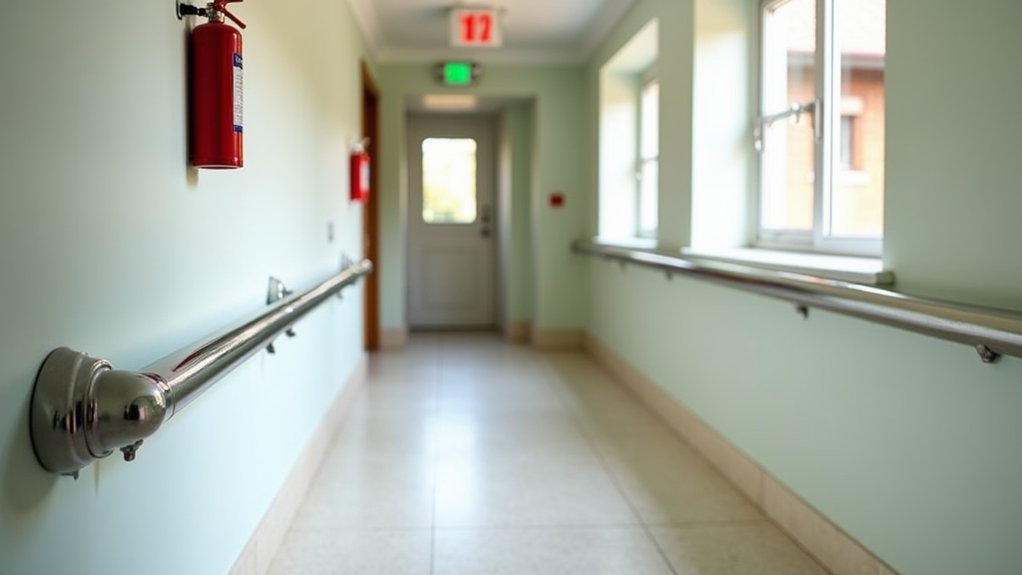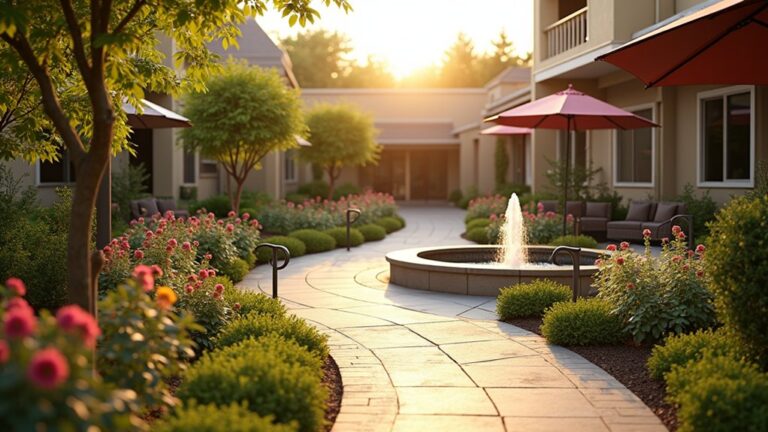How to Ensure Care Home Safety Compliance

To guarantee care home safety compliance, you’ve got to start by understanding key regulations like the Health and Safety at Work Act and CQC guidelines. Conduct regular risk assessments to spot hazards, and train your staff on emergency responses and infection control. Maintain equipment, keep facilities hazard-free, and uphold residents’ rights with empathy. Schedule safety audits and manage incidents promptly. Stick with us to uncover deeper insights on safeguarding your care home environment.
Key Takeaways
- Understand and adhere to Health and Safety at Work Act and CQC guidelines.
- Conduct regular risk assessments to identify and mitigate potential hazards.
- Provide ongoing staff training on safety protocols and emergency preparedness.
- Maintain equipment and facilities through routine inspections and prompt repairs.
- Foster a safety culture by promoting open communication and teamwork.
Understanding Key Health and Safety Regulations

As you commence on guaranteeing care home safety, it’s crucial to first grasp the key health and safety regulations that govern your facility. You’re in a position to protect vulnerable residents, so understanding these rules isn’t just a legal obligation—it’s a moral one.
Start by familiarizing yourself with the Health and Safety at Work Act, which demands you provide a safe environment for both staff and residents.
Next, plunge into specific care sector guidelines, like those from the Care Quality Commission (CQC). These standards guarantee you’re meeting basic safety needs, from proper equipment use to infection control.
Don’t overlook fire safety regulations either; confirm you know evacuation protocols and equipment checks. By studying these laws, you’re equipping yourself to prevent harm and foster trust. Additionally, consider the importance of understanding the breakdown of expenses involved in providing care, as this knowledge can help ensure that safety measures are adequately funded.
Take time to train your team on these regulations, as their compliance directly impacts the well-being of those you serve.
Implementing Risk Assessment Procedures
Countless potential hazards lurk in a care home, so implementing risk assessment procedures is vital to keep everyone safe. As someone dedicated to serving others, you’ve got to identify risks like slips, falls, or medication errors before they harm residents or staff.
Start by walking through the facility with a keen eye, noting anything that could pose a threat. Don’t overlook small details—loose cords or uneven flooring can be dangerous.
Begin by inspecting the care home closely, spotting potential dangers. Even minor issues like loose cords or uneven floors can be risky.
Next, prioritize the risks you’ve spotted. Focus on the most severe and likely issues first, and create a clear plan to address them. Involve your team in brainstorming solutions, as their insights can be invaluable.
Document every step, guaranteeing you’ve got a record of hazards and actions taken. Regularly review and update your assessments to adapt to changing conditions. Your commitment to safety guarantees a secure, caring environment for everyone in your care home. Furthermore, understanding signs of abuse or neglect can help you create an even safer environment by ensuring that residents receive appropriate care and attention.
Ensuring Staff Training and Competency

While maintaining a safe care home starts with risk evaluations, it’s equally critical to guarantee your staff are well-trained and competent. As someone dedicated to serving others, you understand that your team’s skills directly impact resident safety and well-being.
Start by evaluating their current knowledge and identifying gaps. Then, provide regular training sessions on essential topics like infection control, emergency response, and resident care protocols. Don’t just stop at initial training; ensure ongoing education to keep everyone updated on best practices and regulations.
Encourage a culture of learning by offering workshops and hands-on practice. Monitor competency through evaluations and feedback, addressing any weaknesses promptly. Understanding the importance of assisted living can also help staff appreciate the unique needs of residents in their care.
Empower your staff by recognizing their efforts and providing resources for growth. When you invest in their development, you’re not only meeting compliance standards but also fostering a compassionate, capable team ready to serve with excellence every day.
Maintaining Safe Equipment and Facilities
Beyond staff training, you must prioritize maintaining safe equipment and facilities to protect everyone in your care home. As someone dedicated to serving others, you understand that faulty equipment or unsafe spaces can jeopardize residents’ well-being.
Regularly inspect wheelchairs, beds, and medical devices to guarantee they’re in top condition. Don’t wait for breakdowns—schedule routine maintenance and address repairs promptly. Keep records of these checks to stay compliant with safety regulations.
Ensure wheelchairs, beds, and medical devices are always in peak condition with regular inspections and prompt repairs to uphold safety standards.
Additionally, assess your facilities for hazards. Confirm floors are slip-free, lighting is adequate, and handrails are secure. Clear clutter from hallways to prevent falls, and check that fire exits are accessible. A well-maintained environment enhances resident comfort and promotes safety for all.
Train your team to report issues immediately, fostering a culture of vigilance. By staying proactive, you’re not just meeting standards—you’re showing genuine care for those who depend on you. Your commitment to safety builds trust and preserves dignity in every interaction.
Developing Emergency Preparedness Plans

As you focus on safeguarding your care home, developing emergency preparedness plans is a critical step to assure everyone’s safety. You’ve got a responsibility to protect residents and staff, so start by identifying potential emergencies like fires, floods, or power outages.
Draft clear, actionable plans for each scenario, making sure you include evacuation routes, communication protocols, and designated safe areas. Don’t forget to assign roles to your team, so everyone knows their duties during a crisis.
Next, train your staff regularly on these plans. Conduct drills to build confidence and make sure quick, calm responses under pressure. Additionally, ensure that your plans comply with safety features such as fire alarms and surveillance cameras to enhance security.
Keep emergency supplies stocked, including first aid kits, flashlights, and blankets, so you’re ready to support those in your care.
Finally, review and update your plans yearly to address new risks or changes in your facility. Your dedication to preparedness shows your commitment to serving others with care and vigilance.
Monitoring Infection Control Measures
Let’s shift focus to another vital aspect of care home safety: monitoring infection control measures. As someone dedicated to serving others, you understand that protecting residents from infections is a top priority.
Regularly check that staff follow handwashing protocols and use personal protective equipment correctly. Verify you’re inspecting high-touch areas like doorknobs and handrails for proper cleaning and disinfection.
Don’t overlook the importance of training—make sure everyone’s up to date on infection prevention practices. It’s also essential to ensure that you are familiar with state-specific programs that may provide additional resources for infection control.
You’ve got to track and document any signs of illness among residents or staff, acting swiftly to isolate and address potential outbreaks.
Collaborate with health professionals to review and update your infection control policies. By staying vigilant, you’re not just meeting compliance standards; you’re safeguarding the health of those who rely on your care.
Keep pushing for excellence in every step you take to prevent infections.
Upholding Resident Rights and Dignity
While maintaining safety protocols is essential, don’t forget to prioritize upholding resident rights and dignity in your care home. You’re not just a caregiver; you’re a guardian of their autonomy and self-worth. Ascertain you respect their choices, whether it’s about daily routines or personal care.
Listen to their concerns with empathy, and act on them promptly to show you value their voice. Create an environment where residents feel safe to express themselves. Protect their privacy by knocking before entering rooms and keeping personal information confidential.
Encourage their participation in decisions affecting their lives, fostering a sense of control and purpose. Train your team to communicate with kindness and patience, recognizing each resident’s unique needs and history. Additionally, ensure your staff is well-trained in comprehensive emergency preparedness to support residents in times of need.
Conducting Regular Safety Audits
Countless hazards can lurk in a care home, so conducting regular safety audits is essential to protect your residents and staff. You’ve dedicated yourself to serving others, and these audits help guarantee a secure environment where everyone thrives.
Schedule them monthly or quarterly, inspecting key areas like fire exits, electrical systems, and mobility aids. Look for potential risks—loose handrails, slippery floors, or outdated equipment—and address them promptly to prevent harm.
Plan regular safety audits, checking fire exits, electricals, and mobility aids. Spot risks like loose handrails or slippery floors and act swiftly.
As you walk through the facility, involve your team in spotting issues and encourage their input; they often notice risks you might miss. Document every finding meticulously, creating a checklist to track improvements.
Don’t just tick boxes—act on what you discover to show your commitment to safety. By staying proactive, you’re not only meeting compliance standards but also fostering trust and peace of mind for residents, families, and staff who rely on your care. Moreover, understanding the differences between nursing homes and assisted living can help ensure that the facility meets the specific needs of your residents.
Addressing Incident Reporting and Management
Building on the foundation of regular safety audits, you should also prioritize a strong system for incident reporting and management in your care home. When incidents occur, whether they’re minor mishaps or serious events, you’ve got to act swiftly to protect your residents and staff.
Create a clear, accessible process for reporting issues, ensuring everyone knows how to document and communicate concerns without fear of blame. Train your team to respond with compassion and urgency, focusing on resident well-being above all.
Next, analyze each incident to uncover root causes. Don’t just fix the surface problem; dig deeper to prevent repeats. Implement corrective actions and follow up to confirm they’re effective. Ensuring compassionate memory care is crucial in minimizing incidents related to dementia progression.
Keep detailed records to track patterns and improve safety measures. By fostering an open, supportive environment for reporting, you’re not just meeting compliance standards—you’re truly serving and safeguarding those who depend on your care every day.
Frequently Asked Questions
How Can Families Contribute to Care Home Safety?
Wondering how you can help with care home safety? You’ve got an essential role!
Check in often with your loved ones, and don’t hesitate to voice any concerns about their environment.
Join family councils if they’re available, and share ideas for better safety.
Volunteer your time to assist staff, and always report hazards promptly.
Your active involvement guarantees a safer, caring space for everyone in the home.
What Role Do Residents Play in Safety Compliance?
Hey, have you considered what role you, as a resident, play in safety compliance?
You’re essential in creating a secure environment! Speak up if you notice hazards, like spills or faulty equipment.
Follow safety rules, like using handrails or keeping pathways clear. Share your concerns with staff—they’re there to help.
How Are Safety Policies Communicated to Visitors?
When it comes to sharing safety policies with visitors, you’ve got an essential role in creating a secure environment.
Make sure you actively inform them through clear signage at entrances, concise handouts, and verbal briefings during their first visit.
Don’t hesitate to answer questions and offer guidance.
You’re helping protect everyone by ensuring visitors understand and follow the rules, fostering a caring and safe space for all.
What External Resources Support Care Home Safety?
When exploring what external resources support care home safety, you’ll find plenty of help to guarantee everyone’s well-being.
Tap into local health departments for guidelines and training. Connect with organizations like the CDC for updated safety protocols.
Don’t overlook professional networks; they’re gold for sharing best practices. Reach out to industry consultants for tailored advice.
You’ve got the heart to serve—use these resources to protect and care for others effectively!
How Is Feedback From Stakeholders Handled for Safety?
When handling feedback from stakeholders about safety, you’ve got to listen actively and show you value their input.
Start by encouraging open dialogue with residents, families, and staff. Don’t just hear them out—act on their concerns promptly.
Log every suggestion or complaint, analyze it, and implement changes if needed. Follow up with stakeholders to confirm their feedback made a difference.
Your dedication guarantees everyone feels safe and truly cared for.




